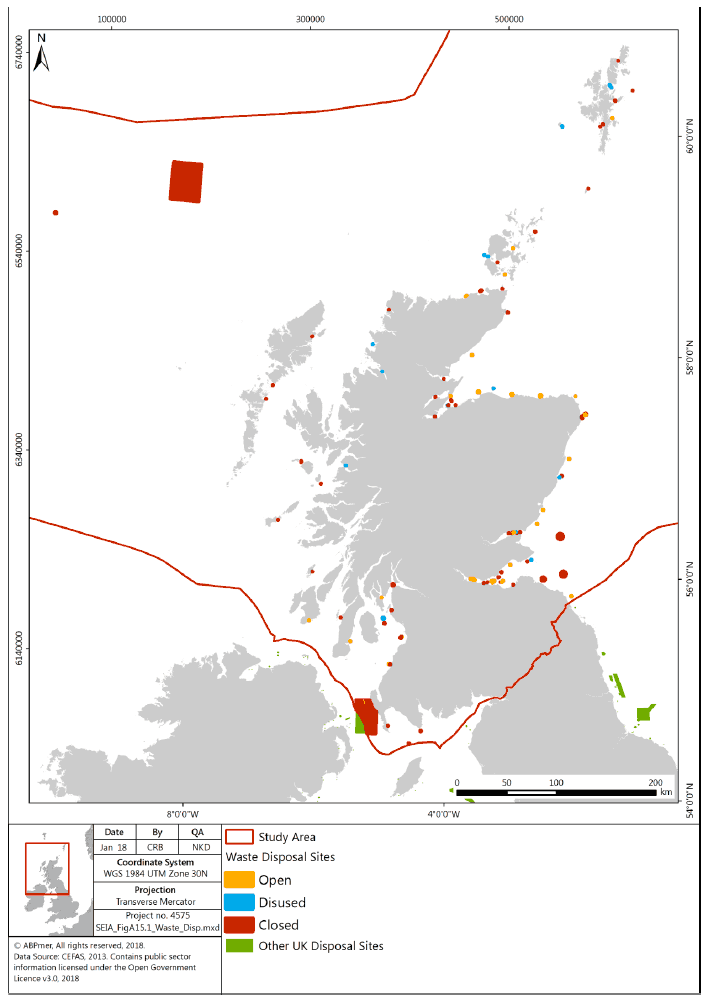Sectoral marine plan for offshore wind energy: social and economic impact assessment scoping report
Sets out the methodology and scenarios for scoping and undertaking a socio-economic impact assessment.
A.16. Waste Disposal (Dredge Material)
A.16.1 Sector Definition
This sector relates to the disposal of material dredged from ports, harbours and marinas, into the marine environment. This type of waste disposal is only allowed where the material cannot be used beneficially, for example to replenish beaches or in construction projects.
A.16.2 Overview of Activity
To facilitate continuous trade into and out of ports, dredging is often required. This involves the removal of sediment and the subsequent disposal of spoil. A total of 118 disposal sites are present in Scottish waters. At present, 32 disposal sites are open and the remaining are either closed or disused (Marine Scotland, NMPi). In 2012, a total of 3.6 million tonnes of dredge spoil was disposed of at open disposal sites in Scotland. The revenue generated from this disposal in 2012 (from licences) was £71,750 (Marine Scotland, 2016).
With regard to future trends, the quantities of spoil material for disposal will primarily be related to maintenance dredge requirements for approach channels to ports and harbours, and port or harbour developments ( e.g. construction of new berths), which may require capital dredging to be undertaken.
Figure A.16.1 shows open, closed and disused waste disposal sites in Scotland. Information sources that can be used in the assessment are listed in Table A.16.1.
Figure A.16.1 Waste disposal sites in Scotland

Table A.16.1 Information sources for the waste disposal sector
| Data Available | Information Source |
|---|---|
| Location of marine waste disposal sites (Scotland) | Marine Scotland NMPi https://marinescotland.atkinsgeospatial.com/nmpi/ |
| Tonnages at open disposal sites (Scotland, to 2012 only) | Marine Scotland http://marine.gov.scot/node/12619 |
A.16.3 Potential Interactions with Offshore Wind
Table A.16.2 shows potential interaction pathways between waste disposal and offshore wind arrays and export cables. Based on the approach to scoping described in Section 2 in the main report, the table also records whether the interaction:
- Is not likely to result in a significant socio-economic impact on the sector; or
- Is likely to result in a significant socio-economic impact on the sector and hence will require a detailed assessment;
The rationale underlying this expert judgement is provided in the table. Where it is not currently possible to make a judgement regarding the likelihood of a significant socio-economic impact due to insufficient information (for example, in relation to the extent of overlap between a sector activity and the DPO Areas) the table indicates that scoping will be required to be undertaken once sufficient information becomes available. Furthermore, as described in the main report, there is currently no information regarding the likely location of export cable routes/corridors and as such, it is not possible to undertake a meaningful assessment of the potential for any sector activity/export cable interaction to give rise to significant socio-economic effects. Rather, the potential for any interaction will be identified in Regional Locational Guidance.
Table A.16.2 Potential interaction pathways
| Potential Interaction |
Technology Aspect and Phase |
Potential Socio-economic Consequences |
Initial Scoping Assessment |
|---|---|---|---|
| Loss or reduced use of dredge material disposal sites |
Arrays (construction and operation) |
Increased costs of disposal ( e.g. through requirement to use alternative disposal site) |
Any potential significant impacts would only be expected where DPO areas overlap with open disposal sites. The location of DPO areas is not currently available. However, depending on the proportion of the DPOs occupied by arrays, there may be scope to avoid impacts through spatial planning. Scoping assessment to be completed once the DPOs defined. |
| Export cables (construction and operation) |
Increased costs of disposal |
Any potential significant impacts would only be expected where export cable routes overlap with open disposal sites. Export cable routes are uncertain. Constraints inshore of DPOs will be identified in the RLG. No detailed assessment possible. |
|
| Obstruction of access to dredge material disposal site |
Arrays |
Increased costs of disposal (through increased vessel steaming times) |
Any potential significant impacts would only be expected where DPO areas lie directly inshore of open disposal sites. Given that all DPOs are likely to be offshore, this is considered very unlikely. No detailed assessment required. |
A.16.4 Scoping Methodology
The spatial overlap between DPOs and dredge material disposal sites to be assessed, once DPO areas are available.
A.16.5 Assessment Methodology
If a significant interaction between DPOs and any dredge material disposal site is identified through scoping, further consideration will be given to the potential socio-economic impacts in consultation with the relevant port and harbour authority.
A.16.6 Data Limitations
Data relating to tonnages of dredge spoil disposed of at marine disposal sites ( i.e. intensity of usage) in Scotland only available up to 2012.
Contact
There is a problem
Thanks for your feedback